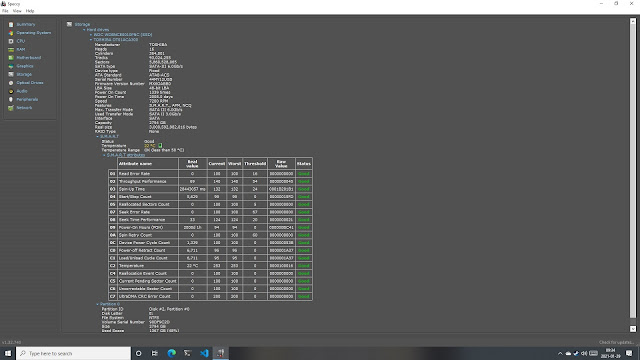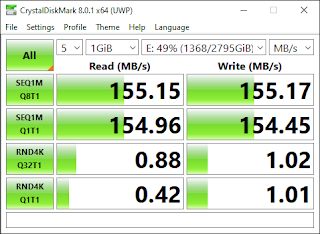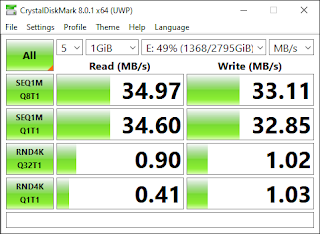Apple Just Gave Millions Of iPad, iPhone Users A Reason To Leave
Computers
“Holy fuck that’s fast” — me on launching Rimuru’s video test.
Input chosen for this case, is of course episode one of That Time I Got Reincarnated As A Slime aka Tensura. My normal preset in Handbrake that most notably for video does a x265 encode at quality 22, which is ample for 1080p anime.
Centauri normally takes about 35 – 40 minutes to complete encoding an episode in this context. Seeing Rimuru reporting average FPS in the 50s, I had a split take and double check that Handbrake didn’t screw up my imported preset settings, and of course it didn’t. Rimuru is just that powerful a demon lord.
Looking like the new estimated conversion time is about 10 minutes per episode rather than 35 minutes. I can almost see Shion’s smiling face in my mind’s eye….lol
When I originally designed Centauri: it was with the spec that it should last at least five years before it would be cost effective to replace it. By that, I mean it has to take so long to do shit that it’s worth money not to have to wait on it. Dear Centauri made it to eight years with most of its bottle necks only showing up in the last couple. I’d say that’s pretty good.
Enter the new generation: Rimuru is reincarnated born.
Since my 5 year design ended up pulling 8 years of duty, I opted for the biggest influencer of that spec. Centauri rocked a Core i5-3570K based on the assumption that it would retire by the time it became the problem, and lo and behold it really was the main bottle neck. As such, Rimuru rocks a Core i7-10700K because I’ve specified parts based on a 10 year service life.
One of the primary goals aside from that was the modernization of technology. Two pieces of tech have been on my mind as possible final retro fits for a few years now.
I’ve reached a point where USB-A only exists for old technology and existing peripherals that have nigh indefinite life span relative to their host computer. Things like my web cam and mouse.
Rimuru sports a snazzy front panel USB-C port perfect for the fact that most of what I want to connect now functions through USB-C. Likewise the motherboard rather resolves one of my gripes with its predecessor. My old Z77 chipset was a superb motherboard but it sadly was a bridge chipset, literally. Coming from the era in which USB 3.0 became standard only two rear ports and the two front ports were 3.0 with the otherwise ample ports in back being 2.0s. On the H570M the only 2.0 ports are header; all rear ports are USB-A, and two of them are rated for 10 Gbit/s. A perfect solution to having to be careful which USB goes where in the back.
While I was at it: I decided on a fairly future proof power supply. My GTX 780 was the root cause of my last power supply upgrade, but is so powerful that it’s not typically the bottleneck Centauri experienced.
Opting to take advantage of the situation: I picked up an affordable power supply off a list of PSUs capable of driving an RTX 3080. In terms of PCI-E power connectors I could run two 780s. It’s also a semi modular—meaning everything but the ATX power cables “Plug” into the power supply rather than having to be tied off and routed. Since Rimuru is operating M.2 NVMe only, and has 2.5″ SSD mounts on the side panel: there is nothing in the drive cages below. As such I tossed the power supply’s remaining cables in there, so I don’t scratch my head in the years to come wondering which box in the closet they landed in.
Somehow it does seem ironic that the first live fire test of Rimuru’s capabilities was playing a DOOM (1993) 😁.
Raw performance testing in more interesting vectors has also been promising. Tested one of my projects that takes Stark about 15 minutes to compile from scratch, and Centauri pulled it off in about 7½ minutes to compile. Rimuru did it in 3 minutes. Bare in mind, Stark is the development system in the family and a laptop of similar vintage to Centauri.
Like her predecessor, Rimuru gets a nice “Assembling” album that tracks and marks things as part of the build. Centauri was the first PC that I built in the era of phones and cameras everywhere, and that really worked out. In a similar lesson from Stark, she also gets her own entry in y note system to serve as a log book of major changes and configuration. I’ve actually got pretty good at coping with that puzzle over the years.
Wait, no wonder my beard is turning grey…lol
Why You Should Stop Using Gmail On Your iPhone
Command, Control, and Optionally conquer the Alternatives
In some ways it may be a touch ironic. For years, I used an Android tablet docked to a monitor, mouse, and keyboard as a workstation; quite happily in fact. Puttering around with iPadOS my only real beef versus doing the same with Android is the keys.
Having spent most of my life around PC based systems, I’m naturally used to the shortcuts on a PC. Such as using control plus left and right to move the cursor a word at a time. On iPad these are more like home/end keys because you use option + left and right to move the cursor a word at a time.
Further complicating the fact is that some familiar shortcuts are control + thing while others are command + thing. For example command + W to close a tab but the familiar control + tab to change tabs. Basically pay back for having owned many a PC but never a Mac, lol.
In terms of keyboard and mouse support the only difference today is that iPadOS sports the same type of mouse based text selection as a PC or Mac. Android and the initial version of iPadOS had simply used it like a finger substitute, and more kludgy in iPadOS’s case. Aside from that I haven’t really had much difference in experience.
One of the notable distinctions as a user however is the software.
Modern iPadOS sports a version of Safari that is as good as Chrome or Edge on my PCs. My Androids on the other hand, being relegated to Chrome was always a bitter existence even if the stability leveled off with the years — and often keyboard/mouse operation in Chrome made my eyes roll out of their fucking sockets at the silly. So let’s just say at web browsers, iPad’s Safari beats Chrome for Android.
For most users I’d call that a win. Most people I know have a heavy slant towards web apps, and thus their connection to the rise of Chrome. In some cases, clutching Firefox like a gunnut and their AR-15s. So the result is Safari doesn’t piss me off, but I’m still one to prefer an app over a browser if you do any kind of decent job at it.
By contrast iPadOS sucks as a terminal client. Networking limitations basically murder any chance of being able to use SSH and multitasking; spend too long away and the connection will be force killed. By contrast in Android land the only real issue with SSH clients I tended to have was the poor copy/paste experiences. Stuff like VNC equally suck on both, but is less multitask friendly on iPad.
For me that’s kind of a negative. 90% of my interest in PCs revolve around command line environment or 3D graphics environments. But given my shift back to laptops for the heavy lifting that’s not been to terrible.
That’s to say, my move from a Chromebook to a Latitude had more to do with Celeron vs Core i5 than it did at using Android apps for terminal work. Likewise, my move from Android tablet to Android apps on a Chromebook was basically generated by Samsung omitted video output on my last tablet.
AT&T customer since 1960 buys WSJ print ad to complain of slow speeds
I remember that spectacular quality and awesome sauce speed from nearly twenty years ago. Where my family lived there was two choices: Bellsouth and Charter. For all intents and purposes today, Bellsouth and AT&T can be considered abotu the same.
I also remember when my mother finally switched to Charter. After that the Internet access sucked a lot less by broadband standards of the word. But I’ll give Bellsouth this mouch, their aDSL service had been a major improvement over a 56 K modem that averaged more like 34 :P.
Huawei’s HarmonyOS: “Fake it till you make it” meets OS development
Forking Android and launching your own rebranded operating system is totally fine. But be upfront about that. Say “HarmonyOS is a fork of Android” instead of “HarmonyOS is not a copy of Android.” Don’t call HarmonyOS “all-new” when pretty much the opposite is true.
A gander at the old hard drive.
| 3 TB of reliable |
So the drive is about 7 years old.
 |
| SMART via SATA native |
 |
| SATA native |
Connected to my desktop’s SATA controller: Crystal Disk Mark shows about the performance I would expect for such a drive.
The symptoms observed with the file server was the drive dismounting whenever I tried to start Plex, or try to see if I could get any SMART via passthrough.
Damningly, if I connect an old Samsung SSD through the enclosure: I get about the same level of performance. While nearly old as the drive the enclosure is a 3.0 with UASP that has generally delivered hard drive performance just fine until recently.
Which reminds me that one of the nifty changes of the new 8 TB drive is loading sections of my Plex is now a hella lot faster on my Fire TV than it used to be.
I think that my spare enclosure made its way to work for various need fillings. So the other of the three is hanging off my Xbox with a 1 TB drive that is probably manufactured circa 2012. Perhaps I will swap that 1 TB drive with this 3 TB drive and use that for a comparison; can break that down into power supply, USB cable, and enclosure without having to pull the PCB. More detailed testing will require hooking it up to my Linux machines.
Possible re-homings include my Xbox for storing games, or adding it to my desktop to store video files being processed for my file server. Both tasks fall under transient data storage, and I’m disinclined to use a drive with over 2,000 power on hours for anything mission critical. Hmm, I think modern Xboxes have a limit of 128 GB – 16 TB for USB 3.0 drives.
There are days when I can sympathize with Mr. Spock’s plight in The City On The Edge Of Forever.
“I am endeavoring, ma’am, to construct a mnemonic memory circuit using stone knives and bearskins.”
Tech things that mildly worry me
I find it just a bit worrisome how often I remember shortcuts for running the MMC‘s various faces.
PS C:UsersTerry> gci C:WindowsSystem32*.msc
Directory: C:WindowsSystem32
Mode LastWriteTime Length Name
---- ------------- ------ ----
-a---- 2019-12-07 04:09 41587 azman.msc
-a---- 2019-12-07 04:09 63081 certlm.msc
-a---- 2019-12-07 04:09 63070 certmgr.msc
-a---- 2019-12-07 04:08 124118 comexp.msc
-a---- 2019-12-07 04:09 113256 compmgmt.msc
-a---- 2019-12-07 04:09 145622 devmgmt.msc
-a---- 2019-12-07 04:09 13091 DevModeRunAsUserConfig.msc
-a---- 2019-12-07 04:08 47682 diskmgmt.msc
-a---- 2019-12-07 04:09 145127 eventvwr.msc
-a---- 2019-12-07 04:09 144909 fsmgmt.msc
-a---- 2019-12-07 04:53 147439 gpedit.msc
-a---- 2019-12-07 04:08 144998 lusrmgr.msc
-a---- 2019-12-07 04:09 145519 perfmon.msc
-a---- 2019-10-15 09:53 146389 printmanagement.msc
-a---- 2019-12-07 04:53 43566 rsop.msc
-a---- 2019-12-07 04:53 120458 secpol.msc
-a---- 2019-12-07 04:09 92746 services.msc
-a---- 2019-12-07 04:09 145059 taskschd.msc
-a---- 2019-12-07 04:08 144862 tpm.msc
-a---- 2019-12-07 06:19 144967 virtmgmt.msc
-a---- 2019-12-07 04:08 115109 WF.msc
-a---- 2019-12-07 04:08 144673 WmiMgmt.msc
In most cases I’m more likely to do foo.msc from a command prompt than go hunt down what I want through the start menu or other methods. Despite my background having focused heavily on unix systems, I’ve actually have learned a fair bit of NT over the past 15~20 years. Don’t think I’ll ever enjoy the care and feeding of Windows systems but it does come with the computer nerd territory, I suppose.
When you consider that for much of the past fifteen or so, the main reason I’ve kept Windows around has been for video games it may be kind of sad and worrisome, lol.
